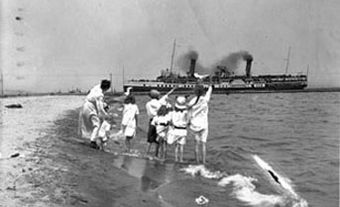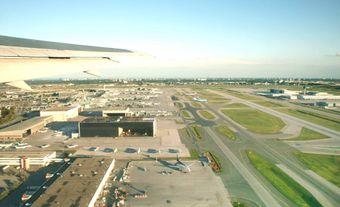Mining Returns to
In 1988, five days before a provincial election, Clifford Frame, the founder and chief executive of Toronto-based Curragh Resources Inc. announced his company was going to open a coal mine in
Curragh Resources put up little of its own money to develop the mine. Under the leadership of Donald Cameron, the area’s MLA and Nova Scotia's Minister of Industry, Trade and Technology, the provincial government agreed to give the company a mining lease, a $12-million loan, and a guarantee to purchase 275,000 tonnes of coal per year for 15 years. In July 1989, with full financing of the $127-million project still not finalized, Curragh suspended development of the mine. Construction resumed a few months later, after Curragh secured a loan guarantee of $85-million and an $8-million interim loan from the federal government.
Early Warning Signs
Even before the mine opened, provincial bureaucrats raised concerns about the Westray development. Early on, the company scrapped the original plans and changed tunnel directions so it could tap into the coal seam sooner.
The Nova Scotia Department of Labour expressed concerns about training and certification of workers, and the lack of an emergency plan.
The mine officially opened on 11 September 1991. In its first two months of operation, the mine experienced four roof falls. Department of Labour inspectors repeatedly asked the company for roof support plans. The Department also raised concerns about the mine's failure to clean up the highly flammable coal dust that lined the floors and walls, and its lack of stone-dusting, a process to neutralize the material's explosive nature.
Weeks before the disaster, a provincial inspector issued an order to have the coal dust cleaned and stone-dusted, but did not enforce the order during a return visit just days before the explosion.
Twenty-six Dead
On 9 May 1992, a quiet Saturday morning, 26 miners were working underground in the Southwest 2 tunnel. Most of the miners were in their early 30's. The youngest was 22 years old, the oldest 56. At 5:20 a.m., sparks from their continuous mining machine ignited methane gas that had not been properly ventilated. On the ground lay dangerously high levels of coal dust that had not been stone-dusted. The combination created a massive explosion that rocked the tiny community of
As distraught family members gathered down the road at the town’s Fire Hall, special mine rescue teams known as draegermen — from Pictou County, Cape Breton and New Brunswick — searched for survivors underground, braving conditions described as “terrifying”. The rescue teams recovered 15 bodies. Finally, on 15 May, six days after the explosion, with no hope of finding anyone alive, search efforts were called off. The bodies of 11 miners were never found.
At the company's first press conference the day after the explosion, mine manager Gerald Phillips said Westray was "as safe a mine as there is."
Inquiry
On the same day that Westray suspended recovery efforts, the provincial government appointed Nova Scotia Supreme Court Justice K. Peter Richard to conduct a public inquiry into the disaster. But due to legal challenges, and concerns the inquiry could impede a criminal investigation, the inquiry did not hold public hearings until November, 1995.
It would be another two years before Justice Richard released his final report, “The Westray Story: A Predictable Path to Disaster." The report was a scathing indictment of the actions, or lack of action, of Westray managers, provincial bureaucrats and politicians. Richard concluded that “(Westray) is a story of incompetence, of mismanagement, of bureaucratic bungling, of deceit, of ruthlessness, of cover-up, of apathy, of expediency, and of cynical indifference."
The report said the mine’s ventilation system, critical to dispersing the deadly methane gas, was woefully inadequate, and it cited Westray management’s repeated violation of safety regulations. It said the Department of Labour failed to discharge its responsibility to enforce those safety regulations, exhibiting an attitude of “apathy and complacence."
The 800-page report contained 74 recommendations ranging from improved training for miners, to an independent review of the province’s Occupational Health and Safety Branch, to a call for legislation to hold corporate executives liable for workplace safety.
The
Clifford Frame refused to testify at the inquiry — which only had jurisdiction in
Charges
Five months after the explosion, the Department of Labour filed 52 charges under the Occupational Health and Safety Act, against Curragh Resources and four local mine managers. At the same time, the RCMP was conducting its own criminal investigation. In December, the province announced it was dropping its charges over fears those trials could interfere with potential criminal charges.
On 20 April 1993, almost one year after the explosion, the RCMP called a press conference at the fire hall in
The families' euphoria was short-lived. The trial began in February 1995, but the charges were stayed when the judge ruled the prosecution had failed to disclose key evidence to the defense. That ruling was appealed twice, and two years later the Supreme Court of Canada ordered a new trial. But on 30 June 1997 Crown Attorneys returned to the fire hall in Plymouth to tell the miners' families that the case was over, they were dropping all charges. After reviewing the evidence, prosecutors believed there was no reasonable chance of a conviction.
Bill C-45
In 2002, following lobbying efforts by unions and the Westray Families Group, the federal government introduced Bill C-45. The “Westray Bill” established a legal duty for all persons who “direct the work of others” to take reasonable steps to ensure the safety of workers and the public. It introduced new sections in the Criminal Code of Canada so that corporations and their representatives can be charged criminally if they fail to do so.
Since becoming law in 2004, fewer than a dozen charges have been laid under the legislation, and no one has been handed a jail sentence. In the three convictions to date, employers paid a fine after reaching a plea bargain. In 2014, the United Steelworkers union, with support from the Westray Families Group, launched a nationwide campaign urging the federal government to give police and prosecutors the training, tools and direction to enforce the provisions of Bill C-45.
Legacy
In the weeks after the disaster, Curragh CEO Clifford Frame vowed to continue operations at Westray. But Frame’s company could not survive the losses incurred following the explosion. In September, 1993 Curragh was placed into receivership, and the Westray Mine never re-opened.
Donald Cameron, the region’s MLA and the cabinet minister who heavily promoted the Westray development, became premier in February 1991. One year after the tragedy, Cameron’s Progressive Conservative government was swept out of power, winning only nine of the 52 seats in the Nova Scotia legislature.
The families of the 26 men who died launched a lawsuit against the province; however the Supreme Court of Nova Scotia ruled the government was protected from lawsuits under the Workers Compensation Act, and the claim was dismissed. The families did receive insurance payments, as well as payments from a $1.8-million dollar fund raised from private donations from across Canada. The fund also provided scholarship funds for the 43 children who were left without fathers.
Shortly after the tragedy, volunteers, tradespeople and family members built a memorial to the men who died, just outside an industrial park in New Glasgow, Nova Scotia. The site sits above what was the North Main tunnel of the Westray mine, the final resting place for the 11 miners whose bodies were never recovered. The names of all 26 miners are inscribed in rays of light from a coal miner’s lamp. Underneath their names the inscription reads “Their light shall always shine."

 Share on Facebook
Share on Facebook Share on X
Share on X Share by Email
Share by Email Share on Google Classroom
Share on Google Classroom



